Southern Patagonia 2018/19 season
overview
By Rolando Garibotti
- Cerro San Lorenzo
- Chalten Massif
- Torres del Paine
- Accidents, responsibility & takeaways
- Further reading: risk managment
The following is a detailed summary of climbing activity in Southern Patagonia during the 2018/19 season. A telegram style list of all important ascents and first ascents can be found here, with each ascent linked to it's corresponding route page.
This past summer season was the third in a row with fairly poor weather and conditions. After having anomalously dry seasons in 2012, 2015 and 2016, it has come as a bit of a shock to go back to average Patagonia weather. The only extended windows of good weather were at the start and end of the season, in November and in March/April.
In early October, Martín Elias, Francois Poncet and Jerome Sullivan did the first ascent of the south pillar of Cerro San Lorenzo, a 1200-meter tall rock tower that was likely one of the hardest virgin summits left in southern Patagonia. Several parties had attempted the northeast face of this tower, but retreated after a handful of pitches. Jerome and partners approached from the north tackling the left side of the east face to then move on to the south face. The rock quality of this formation is terrible, so they followed the path of least resistance. The crux was a two-pitch chimney with terrible rock that required difficult aid. They called their route “La Milagrosa”, 1200m M7 A3 6a.
In the Chalten Massif the ascent of the season came at its tail end, when Jim Reynolds free-soloed up and down Agujas Rafael Juárez and Saint Exúpery, and Cerro Fitz Roy. In the early 1900s, Paul Preuss, considered by many “the father of style” had preached and practiced free-soloing up and down peaks as the “honest, sporting” way to climb (his words). He argued that one should “overcome difficulties with your own strength, on ascent and descent alike,” explaining that “if there is someplace you can’t go down, you should also not go up.” One could have never imagined that Preuss's maxims would be one day applied to a peak like Cerro Fitz Roy.
On Aguja Rafael Júarez, Jim soloed the complete West Ridge (1000m 6b) and down-climbed the Anglo-American (350m 6b), while on Aguja Saint Exúpery he free-soloed Chiaro di Luna (750m 6b+) and down-climbed the Kearney- Harrington (550m 6a+). On Cerro Fitz Roy he free-soloed the Afanassieff route on the northwest ridge (1500m 6a+), taking 6:38hs to reach the summit and 8:30hs to down-climb the same route. He carried a rope and some gear, which he did not use, but he forgot his harness and belay device. He described his approach as the “best possible form of the art”.
There were a other noteworthy ascents in the Chalten Massif. On Aguja Poincenot, Siebe Vanhee completed the first free ascent of Patagonicos Desesperados (500m 7a+), which was onsighted a week later by Leonardo Gheza. There were two ascents of the Southeast Ridge of Cerro Torre, by French and Slovak teams, the seventh and eights ascents of the route. Elsewhere on Cerro Torre, Jorge Ackermann, Tomas Aguilo, and Korra Pesce made an attempt on a difficult line on the left side north face, climbing a total of twenty three pitches, nine on the north face and three above Aguilo's 2013 high-point on the same line. High winds and high temperatures forced them to retreat from the base of the final headwall, which will likely be the crux of the route. The French team that repeated the Southeact Ridge of Cerro Torre also repeated El Corazón on the east face of Cerro Fitz Roy, completing the fifth ascent of the route.
Several smaller new routes were put up in the Chalten Massif. On Cerro Solo, Pedro Fina and Gustavo Tomaschewski Netto climbed “Alpinisisima” following the north ridge, 500m 5 50˚. On El Mochito, after attempts with various partners, Matías Korten rope-soloed “El Camino del Guerrero”, 280m 5.10c A1; Christopher Koppl rope-soloed “Straight outta Nipo”, 300m 5 A3+; and Koppl together with Vitaliy Musiyenko climbed “Mosca para Mujer”, 300m 5 A3. On El Mocho, Ondrej Huserka and Jozef Kristoffy did the second ascent and first free ascent of Bizcochuelo, finding difficulties to 7a+. On the north face of Aguja de la Medialuna, Kiff Alcocer and Jordon Griffer climbed “Harvest Moon,” 250m 6b.
On the west face of Torre Egger, Alessandro Beltrami, Mirko Povinelli, Giorgio Roat, and Ermanno Salvaterra made a valiant attempt in the centre of the west face, climbing two thirds of the way up what is a very steep and fairly blank big-wall. Over two attempts they spent 21 days on the wall on porta-ledges, retreating when their time and food run out. This was Ermanno's fourth attempt of this line, which he hopes to try yet again. On the east face of Torre Egger, Brette Harrington and Quentin Lindfield Roberts climbed the first three pitches of Titanic, then moved left onto virgin ground, climbing nine new pitches to rejoin Titanic at the snowfield half way up the wall, from where they retreated. They called their variation “Marc-André's Vision”, as it was Marc-André Leclerc who first eyed this line. They hope to return to complete their line to the summit, possibly connecting into Titanic.
On the northeast face of Aguja Bífida, Juan Canale, Jonathan Larrañaga, and Oriol Baro climbed a variation connecting The Siren to Cogan (six pitches, 6a+), while Jon Griffin, Tad McCrea, and Luis Scheinkman climbed an alternate start to Cogan (five pitches, 6a C1). On the west face of El Tridente, Martin Lopez Abad, Julian Ferhmann and Diego Simari climbed “El Hedonista”, six new pitches starting from and connecting to “The Secret of the Mountain,” following a very good looking line in the central pillar (to 6b+). On the west face of Aguja Rafael Juárez, Ryo and Sayaka Masumoto climbed a direct finish to Quilombo, finding difficulties to 7a. On Aguja de l'S, Iker and Eneko Pou climbed “Haizea”, seven new pitches in the centre of the east face.
To the southwest of Lago Viedma, and to the east of Cerro Moyano, in an area seldom visited, Daniel Pons and Steffen Welsch did the first ascent of the southern most summit of the chain of which is also part Cerro Huemules. They started from Estancia Helsingfors, walking along the Moyano fjord, taking a side valley immediately west of Cerro Huemules to establish camp after walking six hours, at around 1300 meters. The next day they walked to the base of the northwest face of the unclimbed peak, started climbing at 2100m, doing eight short pitches with difficulties to 5+ and A0. They note that the summit is clearly higher than Cerro Huemules itself, and measured it with an altimeter at 2350m. They christened the peak Nahumaday.
The Torres del Paine Massif in Chile also saw some new route action. Earlier in the year, in June 2018, Max Didier and Cristobal Señoret climbed “Estilo Andino”, a new route on Cerro Paine Grande’s 300m-tall southwest face. Their line climbs to the far left of the existing lines, reaching the heavily rimmed west ridge, which it follows to the summit. They found difficulties to 90˚ and WI4. This was only the fifth ascent of this imposing, beautiful peak which at 2,845 meters, is the highest peak in the Torres del Paine massif. In August, during the winter, Felipe Bishara and Christian Barra Muñoz climbed a new route on the southeast face of Cerro Almirante Nieto. The difficulties begin around 1300 meters, with a 10-pitch long ramp that is followed by eight pitches of mixed climbing and unconsolidated snow with several sections to 75˚ and steps to 90˚. They did the ascent non-stop, taking 31.5 hours round-trip from their car. Also in August, Nicolás Secul and Cristobal Señoret did the first ski descent of the east face of Almirante Nieto, following the line of Genesis, a route put up in 2015.
During the summer season, Secul and Señoret climbed a new route on the southwest face of Cerro Peineta. "Puro Filete” climbs nine pitches on the far right side of the face, with difficulties to 6c A1. On the east face of Cuerno Este, Secul and León Riveros climbed seven new pitches on the golden pillar to the right of “Tchao Pantin”, stopping some 50 meters below the shale band, where the cracks petered out. In the French Valley, and on the left side of Aleta de Tiburón's east face, Max Barlerin and Kevin Sturmer climbed “The 600 lbs Amoeba”, a line that after the initial slabs (150m to 5) has five steep pitches with difficulties to 7a+, to the join the classic South Ridge. The same pair climbed a new line on the east face of Aguja de los Quirquinchos, to the right of a prominent dike. “The Skidmark” climbs five pitches to 6a+.
In mid July 2018, to the south of the Torres del Paine National Park, Tomás Marusic, Nicolás Secul, and Cristobal Señoret did what is likely the first winter ascent and first ski descent of the seldom climbed Monte Balmaceda.
An unfortunate development this season was the number of accidents that occurred in the Chalten Massif. Three climbers died on Cerro Fitz Roy, one on Cerro Solo, and there were three other major accidents that required rescues. It is unclear what might have led to this spike, potentially it could be related to over-eagerness after much bad weather. The three deaths on Cerro Fitz Roy were due to exposure, hypothermia, and occurred on the same day. The two parties involved appear not to have read the forecast carefully enough, as it was clear that was not a day to climb on the high peaks. Neither of the parties had communication devices, which severely hindered the chances of a rescue. On a smaller formation, a climber fell while simul rappelling, suffering a severe concussion with displacement of some of the cranial bones. This party also lacked a communication device and the partner mistakenly thought helicopter rescues were available in the area, so he rappelled to get help instead of bringing his injured partner down. Fortunately he run into two strong parties that proceeded to climb up to the injured person and bring him down. Another accident occurred on the west face of Cerro Torre, where a climber was hit by rock-fall, breaking her leg. There were several parties present, and after calling for help they proceeded to take her down to Circo de los Altares from where a military helicopter was able to fly her out just as a storm was moving in.
Here are a few takeaways to climb safely in Patagonia:
- Carry a communication device, either a VHF radio, a satellite phone or an inReach.
- Learn to read more than one weather forecasting model.
- Climb in teams of three for added man-power and wiser decision making.
- Beware that helicopters are not usually available: on 83% of the 120 rescues carried out in the last 20 years, there was no helicopter involved.
- If you want your partner to survive, you must self-rescue to the base of the wall.
- Practice self-rescue extensively, learning to load your partner on your back and rappel with him/her.
- Hire adequate rescue and travel insurance coverage, at least U$ 10k for the rescue itself and additional coverage for the hospital and repatriation costs.
- Show empathy towards your loved ones and the rescuers by choosing objectives well within your skill level: a climb’s real difficulty is not solely if everything goes right.
- Make plans based on current conditions, not based on objectives you set for yourself months before.
Climbing in Patagonia can be quite fun, but being cavalier in mountains these big can quickly lead to tragedy.
--
Further reading
- "Good Samaritans and responsibility", thoughts on the accidents that ocurred during the 2018/2019 season.
- Risk management considerations for climbing in Southern Patagonia, here (pdf download).
- Climate changes in Southern Patagonia, an article by Dörte Pietron in the 2018 American Alpine Journal, here.
|
Photos: click to enlarge
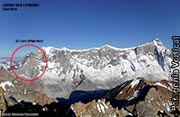
Cerro San Lorenzo - El Faro 
Cerro San Lorenzo - "La Milagrosa" 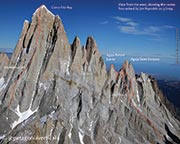
Routes free-soloed by Jim Reynolds 
Patagonicos Desesperados 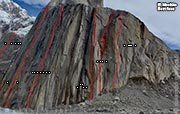
El Mochito
 Torre Egger - west face attempt
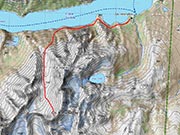
Location of Cerro Nahumaday
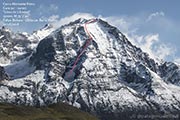
Cerro Almirante Nieto, south face 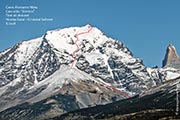
Cerro Almirante Nieto, east face
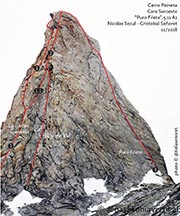
Cerro Peineta, Puro Filete
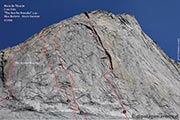
Aleta de Tiburón, east face
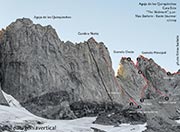
Aguja de los Quirquinchos & Gemelos |
|











